Manuscript accepted on :21-09-2023
Published online on: 26-02-2024
Plagiarism Check: Yes
Reviewed by: Dr. Priya R and Dr Jayanti Mukherjee
Second Review by: Dr. Grigorios Kyriakopoulos
Final Approval by: Dr. H Fai Poon
Adnan Ahmad1* , Mohammad Haneef1
, Mohammad Haneef1 , Nabeel Ahmad2
, Nabeel Ahmad2 , Fariya Khan3
, Fariya Khan3 , Samriddhi Jaswani1
, Samriddhi Jaswani1 , Tuba Arif1
, Tuba Arif1 and Samiya Shakil1
and Samiya Shakil1
1Department of Bioengineering, Integral University, Lucknow, India.
2Department of Biotechnology, School of Allied Sciences, Dev Bhoomi Uttarakhand University, Dehradun, India.
3Stem Cell Research Centre, Department of Hematology, SGPGIMS, Raebareli Road, Lucknow, Uttar Pradesh, India.
Corresponding Author E-mail: haneef@iul.ac.in
DOI : https://dx.doi.org/10.13005/bpj/2838
Abstract
Biodesign is a tool that integrates diverse fields of biology with design for the development of a good lifestyle and, sustainable environment along with futuristic support to the society and ecosystem. Using the approach, Identify-Invent-Implement, the biodesigners identify and unravel the unmet needs of society in the field of healthcare, environment, and architecture sectors by developing novel products and improving technologies with the incorporation of design into it. With evolving technology, biodesign has created an impact globally in the ecology by preventing the ecological imbalance, creating an impact on the psychological behaviour of humans by boosting their confidence and thus influencing one’s behaviour. Biodesign crossed various technological barriers by developing devices such as hearing, and vision aids, prosthetics, implants, and eco-friendly cements and also used microorganisms to enhance the quality of the bricks. Biodesign has crossed the limits of earth curvature and reached space by innovation like future space colonization and protecting indigenous species.
Keywords
Biodesign; Brain Implants; Dunes; Prosthetics; Retinal Implants
Download this article as:| Copy the following to cite this article: Ahmad A, Haneef M, Ahmad N, Khan F, Jaswani S, Arif T, Shakil S. Biodesign: An Innovative Technology for Sustainable Development Goals in Health and Environment. Biomed Pharmacol J 2024;17(1). |
| Copy the following to cite this URL: Ahmad A, Haneef M, Ahmad N, Khan F, Jaswani S, Arif T, Shakil S. Biodesign: An Innovative Technology for Sustainable Development Goals in Health and Environment. Biomed Pharmacol J 2024;17(1). Available from: https://bit.ly/3OVEaNB |
Introduction
The term biodesign is the combination of two words ‘Bio’ meaning “living organisms” and ‘design’ meaning “to create”. Bio-designed products give a quality life to those who suffer the loss or damage to their organs along as well a futuristic approach to society and mankind. Biodesign is a broad range of science and technology including ideas and methodologies that are put into practical use and considerably has been developed for mankind in finding novel solutions or treatments in the healthcare industries and a ray of light to the patients who earlier had no cure for their disability or illness. Biodesign is deeply connected with biotechnology in many aspects such as the use of living organisms with applied sciences and technical knowledge to assemble and fabricate the beneficial and advantageous outcomes useful to mankind1. In the wider sense, it is accepted that biodesign is simply knowing how the biological machinery of living organisms interacts with the technology and innovations developed rapidly at each hierarchical level of the living organism. It includes the vast bioengineering field applications which include the use of biological systems integrated with technology and design to produce products and methodologies useful for the health sector, environment sector as well as aerospace engineering2.
The biodesign process goes beyond biomimicry which is mimicking or imitating the exact using living organisms3. Biomimicry is another branch of science in human engineering that involves the design models associated with nature. This article aims to get a clear idea of biodesign including its applications beneficial for society, the impact of biodesign on the world, and its future possibilities.
The biodesigners first conceptualize and understand the organism, the surrounding environmental conditions, and the way how a particular organism may react when modified for a specific use. Biotechnology plays an important role in the field of biodesign as it uses modest features and technology to build up and augment the various sectors including biotechnology, architecture4, agriculture, environment, healthcare, etc. to help humans live a quality life.
The process of biodesign has been used as a practical tool in the development of artificial organs and devices for the healthcare industry to meet the emerging demands in diagnostics and disease treatment. Artificial organs can be developed both for humans as well as for animals who unfortunately lose an organ or part of an organ resulting from an accident.
IDENTIFY → INVENT → IMPLEMENT
The central schema of the biodesign is the Identify-Invent-Implement; with this approach first, the unmet needs are observed and are then filtered out by determining its specifications. In the next step, Invent, the ideas are filtered out and the analysis of the intellectual property, economic, and business models are evaluated thus, the concept is selected after 3D modeling, prototyping, further evaluation, and selection of the concept. The last step i.e., Implement involves the development of strategy by obtaining the clinical, Research and Development (R&D), sales strategy, and carrying out the clinical test if required followed by the filing of the patent and integration. These three phases turn the needs into the solution to advance and improve the field of biotechnology as well as healthcare.
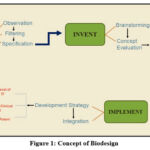 |
Figure 1: Concept of Biodesign |
Applications
The major applications of biodesign include the architecture, healthcare, cosmetology, environmental, and aerospace industries of society.
 |
Figure 2: Applications of Biodesign in various aspects |
In the architectural industries, it allows the use of microorganisms and integrates them with the existing tools and materials for the advancement of architectural structures by allowing them to be more rigid5.
In the healthcare and cosmetology industry, the process of biodesign can be used to manufacture various devices that can be used for medical treatment, diagnostics, and therapy. It also allows us to develop new strategies for implantation and methodologies for the treatment and development of prosthetic organs like Lower Limb Prosthesis, Hernia Graft, Head & Neck Surgery, Breast augmentation and breast reconstruction surgery, Nipple reconstruction surgery, Vaginal reconstruction, Gluteal Augmentation, Ear surgery, Dental Implants, Otologic grafts, Gold eyelids, and organ-on-a-chip.
Implants
Lower Limb Prosthesis
To overcome leg amputation due to severe infection or accident, a novel type of electronically controlled artificial limb has been developed using biodesign having a piece of sensor equipment for controlled movement of the limb. This artificial limb is simple and highly reliable6. This type of lower limb prosthesis prevents oil seeping and is lighter in weight. This lower limb prosthesis also creates a new generation of super athletes that has the potential to push the boundaries of human performance.
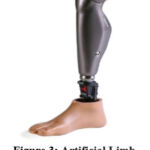 |
Figure 3: Artificial Limb. Photo Credit: Hanger Clinic |
Bionic Arm
For the people who lose their hand or any part of the upper limb due to an accident or upper limb amputation because of any bacterial, viral, or fungal infection, cancerous tissue in the muscle or bone of the hand, severe diabetes, frostbite, artificial bionic arms have been developed which are reliable, versatile and allow the patients to regain the sense of touch. These bionic hands are fully functional and convert the electrical impulse into movement allowing them to function like a normal hand. These modern prosthetics are costly and not everyone can afford them, an Indian start-up Makers Hive has developed a cheap and more functional bionic arm7 known as The KalArm, a lightweight 3D printed bionic arm that features panels that can be customized, 16 grips, and an application to monitor the arm’s performance.
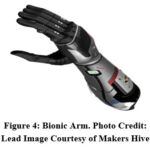 |
Figure 4: Bionic Arm. Photo Credit: Lead Image Courtesy of Makers Hive |
Breast Augmentation and Reconstruction Surgery
With the help of silicone or saline implants, women can undergo breast augmentation which is just done to increase the size of the breast. The technique of breast augmentation helps women boost their self-esteem and be confident in their personality and physique8. Breast reconstruction surgery has been performed mainly on those patients who undergo mastectomy and mainly on women diagnosed with breast cancer. The surgery is performed by implanting the stem cells and adipose-derived stem cells, including the basic fibroblast growth factor that helps in enhancing tissue regeneration9.
Scaffolds, the structures that support the tissue repair and growth of cells after implanting them into the patient, facilitate cellular growth, and these biological scaffolds are composed of collagen or a decellularized tissue matrix10.
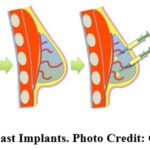 |
Figure 5: Breast Implants. Photo Credit: Chhaya et. al.9 |
Nipple Reconstruction Surgery
Due to breast cancer or high risk of breast cancer, a patient has to undergo a surgical operation known as mastectomy that includes the removal of the breast along with the nipple from the patient’s body11. The regeneration of the nipple requires nipple reconstruction surgery which is performed with the help of a Nipple Reconstruction Cylinder (NRC) which is a cylinder of extracellular matrix collagen from porcine sub-intestinal submucosa12. This reconstruction of the nipple is not necessary and it depends on an individual’s choice. This reconstruction of the nipple does not affect breastfeeding.
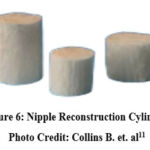 |
Figure 6: Nipple Reconstruction Cylinder. Photo Credit: Collins B. et. al11 |
Vaginal Reconstruction Surgery
If any vaginal injury is caused while giving birth or soreness with sexual activity, reconstruction of the vagina is required. Small intestine submucosa (SIS) is an extracellular matrix present between mucosal and muscular layers of the small intestine of porcine and is mainly used as a tool for the reconstruction and regeneration of various tissues and muscles of the body13. The vaginal reconstruction is performed with the help of a biological graft which is placed onto the vaginal front and rear walls. The biological graft approximately takes 2 months to produce a non-widened (narrow) vagina14.
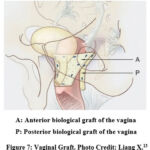 |
Figure 7: Vaginal Graft. Photo Credit: Liang X.13 |
Gluteal Augmentation
Commonly known as Buttock Augmentation performed with the help of implantation known as Gluteal implants or Buttock implants. The implants are made up of solid silicone that is used in medical procedures which increases the definition of gluteal muscles. Women undergoing physical discomfort due to a flat or very flat butt opt for Gluteal Augmentation15. Buttock augmentation is performed mostly for females to enhance the body structure but the implants are also available for men to improve the flat-shaped butt and enhance its structure.
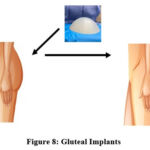 |
Figure 8: Gluteal Implants |
Otologic Graft
Reconstruction of the middle ear was performed with the help of a biodesign graft. Using temporalis fascia for the reconstruction of the middle ear required a separate scar which eventually was replaced with a biodesign graft and using this biodesign graft the results became significant showing a 92.3% intact graft rate16.
 |
Figure 9: Otologic Graft. Photo Credit: Cook Medical. |
Dental implants
Due to infected gums and fewer units of the functional tooth,the ability to chew food reduces, and dental implants are then used which are made up of titanium and are implanted to restore the chewing ability of an individual, these implants are also known for the replacement of tooth roots to provide support for the artificial teeth, crowns, and dentures17.
 |
Figure 10: Dental Implants. Photo Credit: implantME |
Dural Graft
The graft implanted in the extracellular matrix that is derived from the small intestine submucosa of porcine. This dural graft is used for repairing the dura matter. The advantages include that it does not swell up with hydration and is also not able to fold itself18.
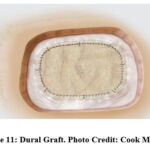 |
Figure 11: Dural Graft. Photo Credit: Cook Medical. |
Recently, a digital bridge has been created between the brain and the nerves in the form of a device that is known as a brain-spine interface. With the help of this device, a connection is provided between the brain and spinal cord which allows the thoughts to control the movement19.
Cardiac event monitor
A novel, 14-day monitoring device, commercially available in the United States and Europe for the monitoring of cardiac arrhythmias (irregular beating of the heart). It is a one-time use device, resistant to water with a patch-based disposable monitor made by the three phases of biodesign: Identify, Invent and Implement20.
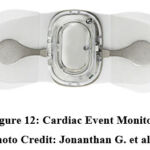 |
Figure 12: Cardiac Event Monitor. Photo Credit: Jonanthan G. et al.20 |
Open Abdomen Device
Laparotomy, a surgery involving an incision into the abdominal cavity to examine and diagnose the abdominal organs, requires an Open Abdomen (OA) therapy for the closure of the abdomen. This closure is facilitated by a temporary abdominal closure device (TAC) that is installed for the closure of the abdomen during the Open Abdomen (OA) therapy. This TAC device lacks some functionality and is modified with the help of biodesign using the approach Identify-Invent-Implement where a simulator is used that acts upon properties including both physical and mechanical properties of the open abdomen21.
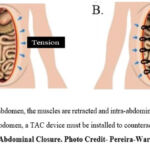 |
Figure 13: Temporary Abdominal Closure. Photo Credit- Pereira-Warr & Sierra-Marin, 2018 |
Organ-on-a-chip (OOAC)
This is a useful technique and procedure using a microfluidics chip for the development of the organ on the microfluidic chip. It saves us from animal testing in the clinical trial of the drug development process. OOAC requires a microfluidics chip that has micro-channels engraved into the material which is generally glass, silicon, or polymer such as PDMS, Poly Dimethyl Siloxane; A biological living tissue: the stem cell is generally used, stem cell is a cell that can clone itself indefinitely while differentiating and produce specialized and fully-functional cells for various tissues and organs of the body22; the activation or the process of drug delivery; and sensing. The multiple organs developed using this technique include the lung, heart, kidney, liver, intestine, and brain23.
 |
Figure 14: OOAC using a Microfluidic Chip |
Radio chip mimics the human ear
In the inner ear, the tiny hair cells are activated by the conversion of the sound waves into mechanical waves which in turn then create electrical signals. An artificial cochlear radio chip was developed mimicking the functioning of the human ear which detected television, radio, internet, and cell phone signals24.
 |
Figure 15: Radio Chip Photo Credit: Anne Trafton |
Animal prosthetic organ
Apart from the development of prosthetic organs in humans, biodesign has also been found useful for the development of prosthetic organs in animals such as the beak in the eagle (Figure 2.6.1) that had been shot and lost the mandible part of her beak25. The eagle was then unable to chew and was successfully operated on and implanted with an artificial beak. This artificial beak not only regained its ability to chew but also completed its beak giving it a beautiful appearance.
 |
Figure 16: Artificial Beak. Photo Credit: Claire Bates |
Another example of the prosthetic organ in animals is the functional prosthetic leg in the elephant Mosha (Figure 2.6.2) in the Asian region who earlier weighed 1,300 pounds during her injury and after the prosthetic leg implementation, Mosha weighed about 4,400 pounds26. Mosha lost her leg in the landmine and is the first-ever elephant to receive a fully functional prosthetic leg.
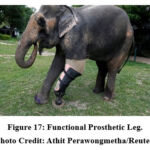 |
Figure 17: Functional Prosthetic Leg. Photo Credit: Athit Perawongmetha/Reuters |
Prosthetic limbs, made up of titanium, are also developed for other animals that help the animal get back to its feet and gain the capability to walk back again. Such examples of prosthetic limbs include the case of Dymka, a cat, who lost its ability to walk due to frostbite. The cat was then able to get back on its feet after the implantation of the prosthetic or artificial limbs27. Similarly, thousands of other dogs and cats have been implanted with prosthetic limbs and paws.
Fuji, a dolphin, is the first dolphin worldwide that had a prosthetic tail made of silicone, (Figure 2.6.3) with foamed rubber cushioned in between and then supported with carbon fibers. Due to necrotic disease, Fuji had lost its tail and was unable to jump, perform tricks, and flips. After the successful implantation of the tail, the dolphin regained its ability and was successful in jumping, flipping, and performing various tricks28. Another dolphin named Winter got her tail amputated as the circulation stopped due to entanglement of the tail in the crab trap line29.
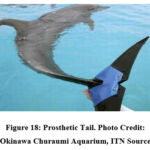 |
Figure 18: Prosthetic Tail. Photo Credit: Okinawa Churaumi Aquarium, ITN Source |
Biocouture and Biobrick
In the manufacturing of biocoutureusing particularly dead biomass such as cellulose, another material has been produced known as biocouture that is made using microorganisms mainly sugar-eating bacteria which are used to create a leather-like material that can be used in the textile industry30. This will help reduce the slaughter of animals for textile-ready leather production. The leather-like material is made by the production of nanofibers (fibers in the nanometer range of 10-9m) of cellulose31.
The use of conventional brick is an alternative to the use of biobrick which takes 3 days for its construction. A high amount of toxic gas is released and higher usage of agricultural soil is required for the production of conventional brick. Biobrick is produced with the help of the microorganism Bacillus pasteurii provides high strength and is less harmful to the environment32. With the help of the bacteria Sporosarcina Pasteurii,self-healing concrete is also developed. This bacterium under some defined conditions secretes limestone which fills the crack by mixing it with proper nutrients. The advantage of this concrete includes the less emission of carbon4.
 |
Figure 19: Biobrick. Photo Credit: Bio Mason |
Microalgae-Integrated Buildings
Architects and designers use microorganisms and integrate them with the design for the formation of integrated buildings that will lead to a sustainable future. The buildings integrated with microalgae helps decrease carbon dioxide emission. This can open and close according to changes in temperature and is a part of Abu Dhabi towers33.
 |
Figure 20 Al-Bahar Towers. Photo credit: www.arup.com/projects/al-bahr-towers |
Dune
To prevent the spread of deserts, the sand particles present in the desert, urea and calcium sources along with water when integrated with the bacteria Bacillus pasteurii, form rigid architectural structures that can be used as a shelter, for protection of trees, and collection of moisture that will help prevent desertification. These dunes produced are cost-efficient and reliable30.
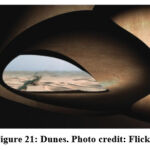 |
Figure 21: Dunes. Photo credit: Flickr |
DAPHNE Device
Apart from various implantations used in the healthcare or medical industry, biodesign is also used for the diagnosis of the neuro-psychophysical34 condition of a person through cineto-dynamic parameters. This device is known as a DAPHNE device and has been developed by Robotics Lab, Politecnico of Milan35.
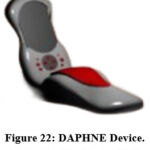 |
Figure 22: DAPHNE Device. Photo Credit: Canina M.35 |
Some other applications of biodesign include the bio-inspired computer that indicates cat brains and the formation of bolt threads which are produced using genetically modified organisms from dead biomass36.
A wireless remote-controlled neuromodulation device has been developed using the three phases of biodesign: identification followed by invention and implementation. The device connects the patient remotely with a remote clinician and all the records and data are maintained on the wireless device. The device has already been launched in the United States, Europe, and Australia and is currently available on iOS. Successful trials of the device have been reported and out of 858 total sessions, 14 sessions were not successful and failed even after retrying37.
ZiBiPen
EpiPen or theEpinephrine pens first created for self-administration of adrenaline through auto-injectors, were expensive and could not be reused. These EpiPens are then replaced with ZibiPen, developed by the University of Cape Town Medical Devices laboratory using the process of frugal biodesign that helps in developing novel medical devices at low cost and using fewer resources38. The ZiBiPen can be reused with an adjustable length of the needle for proper delivery of the drug into the deliberate muscle. For the treatment of anaphylaxis, this ZiBiPen is used that allows multiple dosages with changeable cartridges thus, reducing its cost39.
 |
Figure 23: ZiBiPen. Photo credit: University of Cape Town Medical Devices Laboratory |
Impact
A major socio-economic and environmental impact has been in the world after the innovation and implementation of biodesign. It has allowed the patients hope in the course of their treatment for some particular disease. For example, humans who due to some cause lost their organs or any other body part can get a regeneration procedure for their respective organs. Those patients who have lost their leg in an accident or by birth and cannot walk can get a prosthetic leg which brings hope and a happy emotion within themselves and thus, helps create a positive attitude towards life and keeps them mentally as well as physically fit. Biodesign approaches can lead to innovations in injury prevention and rehabilitation, helping athletes recover faster and maintain their peak performance levels.
Biodesign has even restricted the use of animals for pre-clinical and clinical trials. Now the trial could be performed on synthetic materials or organs such as OOAC being the present day and the best example of not using human or animal models for the experiment and trials to get the results. The use of animal and human models is unscrupulous and thus the development of OOAC restricts the use of in-vivo models in the process of drug development40.
Biodesign not only has created an impact on the healthcare system of the world but also on the surrounding environment and architecture41. Integrating the use of living organisms into the environment to safeguard the living world has had a great impact on biodesign to the world.
Biodesign will greatly impact the ecology and can be used for the protection of endangered species, thus preventing ecological imbalance. Biodesign can be used to restrict and prevent the burning of fossil fuels and also the fossil fuels can be replaced with efficient biofuels using the process of biodesign including its three phases of Identification, Invention, and Implementation of a novel technology could be generated that would eliminate the toxic and harmful carbon dioxide directly from the atmosphere.
Carbon emission from construction sites also impacts greatly on the atmosphere in the environment42. Biodesign has also found a way to reduce this carbon emission by the use of certain biological materials linked with architectural structures to find novel solutions for the decrease in carbon emission from construction sites and the raw materials used.
Apart from its growing impact in the healthcare industry and ecology of the world, biodesign has also created an impact on the mindsets of people as they are being influenced towards the use of more bio-designed products. For example, through vaginal reconstruction surgery, women can have an immense sense of pleasure which was not possible for those women having vaginal anomalies. Through augmentation of organs such as the butt, breast women feel confident enough with high self-esteem. Not only in the case of women, but men also enhance their body shape through the augmentation of flat butts, they undergo augmentation surgery that boosts their self-esteem as well as changes their psychological behaviour towards their physique, thus bringing more confidence in life.
With the help of a microfluidics chip, an embryonic heart has been developed which can be used for the development of pluripotent stem cells. The first stem cells to be formed are the blood stem cells, which are formed from the aorta of the embryonic heart after the first heartbeat. This development of the embryonic heart has been performed on the stem cells of the zebrafish43.
More than the testing of cells in the petri dish, organs-on-a-chip are more realistic and authentic models that are useful for clinical trials as well as drug discovery and development. These chips are yet to be tested for their functioning in human tissues but some companies have developed them to mimic diseased organs. A heart-on-a-chip, for example, is a miniaturized microfluidic device that mimics the physiology of the heart. It creates a microenvironment for the testing of cardiac drugs and their approaches and also reduces testing on animals44.
Future Possibilities
With the help of biohybrid design, designers have focused on space colonization on planets specifically Mars which focuses on the protection of indigenous species and resources. Nature is now transformed with the help of new and advanced technologies giving rise to a hybridized and symbiotic techno natural/ nature technical future2.
A major recent breakthrough has been recognized which can be a treatment and cure for cancer and genetic blood diseases. With the help of the development of the embryonic heart, pluripotent stem cells can be generated which can be used for further generation of blood stem cells and thus for curing cancer43.
The neuromodulation device discussed earlier requires scalability and integration with more Digitech and advanced use for treating cancer and other genetic disorders.
Retinal Implant
A novel implant has been developed that allows patients to help restore vision that works with smart glasses that are equipped with a camera and a microcomputer that uses electrodes that transmit the signals for stimulation of the retinal cells45. These retinal implants help to regain back sight for blind people but are yet to be tested on humans.
 |
Figure 24: Retinal Implants |
With the help of the novel tools and technologies developed and those in the process of development, it can be accepted that biodesign is being widely used for the production and development of a sustainable ecology for future generations.
Climate change has been a major issue worldwide. To overcome this, biodesign may and is playing a major role by restricting the use of those substances which disturb the ecological balance of the world and using living organisms such as plants, microbes, and algae for maintaining the ecology and proceeding towards a sustainable future.
An apple variety has been developed into an early prototype for a prosthetic ear, by removing all the cells of the apple and growing new human cells on a scaffold. This has been completed in trials with mice, thus showing it to be biocompatible is yet to have human trials46. To reduce the cost and availability of the prosthetics, a team of scientists took a McIntosh (Canadian variety) apple and removed all the cells from a slice, and on the cellulose structure, they grew new human cells, scaffolded, and sculpted that into an ear. The results after clinical trials with mice showed that in some cases, it grew blood vessels that flowed into the implants and the structure was biocompatible.
With the help of Neuralinks brain implants, the innovator and visionary Elon Musk has a mysterious startup plan for a brain chip that will translate the thoughts of the person into action47. This implant would not only help treat brain diseases but also cure them. The implants have been tested on pigs but are yet to be tried on humans but with the pace of growing technology, it could be seen in the coming future.
Conclusion
Biodesign is a powerful tool to cater the current problems associated with the environment, healthcare, wildlife, architecture, and surgical procedures. The use of biodesign in designing artificial organs has increased to by extending its arms to the different fields associated with the daily life of humans and animals. The need for a sustainable environment is also being addressed by the biodesign in terms of Biobrick and micro algae integrated buildings which are used to decrease CO2 emission resulting in the prevention of ozone layer depletion. The concept of dunes is adopted by various countries and is widely used to give shelter to humans, and animals along with preventing desertification of the land. Biodesign also touches the limit of the sky and space by protecting endogenous species and future space colonization. The biodesign has not only changed the way of living but also has given new horizons to amalgamate technology with the design to give high-value living and confidence to humans as well animals suffering from organ loss. In the future, the term biodesign will possibly be applied to almost all the fields of science giving futuristic, cost-effective, and efficient products.
Acknowledgment
The authors are grateful to Prof. Syed Waseem Akhtar, Hon’ble Chancellor, and Prof. Javed Musarrat, Hon’ble Vice-Chancellor, Integral University for providing necessary support to carry out this study.
Conflict of Interest
The authors declare no conflicts of interest relevant to this article.
Funding Source
Not Applicable
References
- Pavlovic M. Bioengineering: A conceptual Approach. 1st ed. Heidelberg New York Dordrecht London: Springer Cham; 2015. pp. 1-13
- Hoyos CM., Daneluzzo M., Tchakerian R., Patel SV., Morais RL. Biomimicry and biodesign for innovation in future space colonization. Biomimicry for Aerospace.2022 ISBN 978-0-12-821074-1
- Deniz, I., & Keskin-Gundogdu, T. Biomimetic Design for a Bioengineered World. In G. Kokturk, & T. D. A. Altun (Eds.), Interdisciplinary Expansions in Engineering and Design with the Power of Biomimicry. IntechOpen. 2018. https://doi.org/10.5772/intechopen.72912
CrossRef - Dosier G. Methods for making construction material using enzyme producing bacteria. Patent No: US 20110262640 A1. 2011
- Andreen D., Goidea A. Principles of biological design as a model for biodesign and biofabrication in architecture, Architecture, Structures and Construction. May 11, 2022 https://doi.org/10.1007/s44150-022-00049-6.
CrossRef - Selvam PS., Sandhiya M., Chandrasekaran K., Rubella DH., and Karthikeyan S. Prosthetics for Lower Limb Amputation. Prosthetics and Orthotics. IntechOpen; 2021. http://dx.doi.org/10.5772/intechopen.95593
CrossRef - KalArm- Houser K. 2021 https://www.freethink.com/technology/ inexpensive-bionic-arm
- Ramachandran K. Breast augmentation Indian J Plast Surg 2008; 41 (Suppl): S41-S47
CrossRef - Chhaya, M. P., E. R. Balmayor, D. W. Hutmacher, and J. T. Schantz. Transformation of breast reconstruction via additive biomanufacturing. Sci. Rep. 6:28030, 2016.
CrossRef - Donnely E., Griffin M., Butler P. Breast Reconstruction with a Tissue Engineering and Regenerative Medicine Approach (Systematic Review). Annals of Biomedical Engineering, Volume 48, No. 1, 9-25, October https://doi.org/10.1007/s10439-019-02373-3
CrossRef - Collins B., Williams J., Karu H., Hodde J., Martin V., Gurtner G. Nipple Reconstruction with the Biodesign Nipple Reconstruction Cylinder: A Prospective Clinical Study. Plast Reconstr Surg Glob Open 2016 Aug; 4(8): e832. PMID: 27622100
CrossRef - Jabor MA, Shayani P, Collins Jr DR, Karas T, Cohen BE. Nipple-areola reconstruction: satisfaction and clinical determinants. Plastic and reconstructive surgery. 2002 Aug 1;110(2):457-63.
CrossRef - Liang X. A Novel Technology for Vaginal Reconstruction Using Porcine Small Intestinal Submucosa. Plast Reconstr Surg Glob Open. 2016 Jun; 4(6): e753 PMCID: PMC4956865 PMID: 27482492
CrossRef - Mirnezami AH., Gonsalves S., Gatt M., Sagar P.M. Ileal pouch-vaginal fistula: treatment with the new Surgisis ® Biodesign ™ fistula plug. Tech Coloproctol 13, 259-260 (2009).
CrossRef - Asani A., Vecchio D. Composite Buttock Augmentation: The Next Frontier in Gluteal Aesthetic Surgery. Plastic and Reconstructive Surgery, Volume 144- Issue 6, 1312-1321, 2019 doi: 10.1097/PRS.0000000000006244
CrossRef - Baruah P., Tzifa K. Biodesign as a graft material in paediatric ear surgery-endoscopic and open approach. The Journal of Laryngology & Otology, Volume 130, Supplement S3, 2016.
CrossRef - Barfeie, A., Wilson, J. & Rees, J. Implant surface characteristics and their effect on osseointegration. Br Dent J 218, E9, 2015. https://doi.org/10.1038/sj.bdj.2015.171
CrossRef - Yu X., Yue P., Peng X., Ding H., Lei N., Yu X. A dural substitue based on oxidized quaternized guar gum/ porcine peritoneal acellular matrix with improved stability, antibacterial and anti-adhesive properties. Chinese Chemical Letters, 2022 https://doi.org/10.1016/j.cclet. 2022.06. 014.
CrossRef - Lorach H., Galvez A., et al. Walking naturally after spinal cord injury using a brain-spine interface. Nature. 2023.
CrossRef - Schwartz JG., Kumar UN., Azagury DE., Brinton TJ., Yock PG. Needs-Based Innovation in Cardiovascular Medicine: The Stanford Biodesign Process. JACC Basic Transl Sci. 1(6): 541-547; 2016; doi: 10.1016/j.jacbts. 2016. 06.011 PMCID: PMC6113348 PMID: 30167537
CrossRef - Sierra, M., Pereira, S., Isaza, J. F., Montoya, I. D., Diaz, C. A., Velásquez, D., Londoño, C. (2021) ‘Development of Open Abdomen Device Based on Biodesign Methodology’, in Proceedings of the International Conference on Engineering Design (ICED21), Gothenburg, Sweden, 16-20, 2021. DOI:10.1017/pds.2021.125
CrossRef - Wnorowski A., Yang H, Wu JC. Progress, obstacles, and limitations in the use of stem cells in organ-on-a-chip models. Adv Drug Deliv Rev. 2019; 140:3–11. https://doi.org/10.1016/j.addr.2018.06.001.
CrossRef - Wu Q., Liu J., Wang X., Feng L., Wu J., Zhu X., Wen W., Gong X. Organ-on-a-chip: recent breakthroughs and future prospects. BioMed Eng OnLine; 1-19; 2020 https://doi.org/10.1186/s12938-020-0752-0
CrossRef - Massachusetts Institute of Technology. “New Radio Chip Mimics Human Ear.” ScienceDaily; 2009; www.sciencedaily.com/ releases/2009/06/090603131441.html
CrossRef - Royce AC. From the Tip of a Beak to the End of a Tail. Science & Children. 2018
CrossRef - Tukes T. A land mine blasted her leg: 10 years later, Mosha the elephant gets new prosthetic. Today: Today.com, 2016.
CrossRef - Miller S. Prosthetic Legs for Dogs and Cats go High-Tech. Newsweek: Newsweek, 2015
CrossRef - Ueda K., Murakami M., Kato J., Miyahara H., Izumisawa Y. Intervention to improve the quality of life of a bottlenose dolphin that developed necrosis on the tail flukes. J Phys Ther Sci. 2013;25(9):1201-7. doi: 10.1589/jpts.25.1201. PMID: 24259946; PMCID: PMC3818761.
CrossRef - Winter the Dolphin. Hanger, Inc.,2020. ISBN: 978-0-545-34830-0 hangerclinic.com
- Myers W, Antonelli P. BioDesign: Nature Science Creativity. 1st ed. Thames & Hudson, London: The Museum of Modern Art (MoMA); 2012. 288 p
- Stylianou M. Biocouture from the lab to the high street. WIRED Magazine 2014 https://www.wired.co.uk/article/biocouture-from-the-lab-to-the-high-street
- Radeck J, Kraft K, Bartels J, Cikovic T, Dürr F, Emenegger J, et al. The bacillus BioBrick box: Generation and evaluation of essential genetic building blocks for standardized work with Bacillus subtilis. Journal of Biological Engineering. 2013;7(1):29
CrossRef - Cilento K. “Al Bahar Towers Responsive Façade/ Aedas” Archdaily 2012. http://www.archdaily.com/270592/al-bahar-towers-responsive-facade-aedas
- A. Rovetta, “Daphne System for Neuromotor Control Evaluation: Reconfiguration Concepts,” 2009 Advanced Technologies for Enhanced Quality of Life, 2009, pp. 3-14, doi: 10.1109/AT-EQUAL.2009.10.
CrossRef - Canina M. Biodesign: Overcoming Disciplinary Barriers Proceedings of the 9th Biennial ASME Conference on Engineering Systems Design and AnalysisESDA08 July 7-9, 2008, Haifa, Israel
CrossRef - Kristensen S., Esat R. Classification of Bio-Design Applications: Towards a Design Methodology. International Design Conference- Design 2018, pp-1031-1042
- Silburn, P., DeBates, S., Tomlinson, T. et al. Rapid development of an integrated remote programming platform for neuromodulation systems through the biodesign process. Sci Rep 12, 2269; 2022. https://doi.org/10.1038/s41598-022-06098-7
CrossRef - Sivarasu S. Frugal Biodesign: An approach for Developing Appropriate Medical Devices in Low-resource Settings. Biomedical Engineering for Africa
- ZiBi Pen : 2018 https://uct.portals.in-part.com/RQx7nmPX0ZeM?utm_source=technologies&utm_medium=portal
- Stolpe A. van de, Toonder Jd. “Workshop meeting report Organs-On-Chips: human disease models”. Lab on a Chip. 13 (18): 3449–70. 2013 doi:10.1039/c3lc50248a. PMID 23645172.
CrossRef - Andreen D., Goidea A. Principles of biological design as a model for biodesign and biofabrication in architecture, Architecture, Structures and Construction. May 11, 2022 https://doi.org/10.1007/s44150-022-00049-6.
CrossRef - Kırdök, O., Altun, T.D., Dokgöz, D. and Tokuç, A. ‘Biodesign as an innovative tool to decrease construction induced carbon emissions in the environment’, Int. J. Global Warming, Vol. 19, Nos. 1/2, 2019 pp.127–144.
CrossRef - Li J., Nordon RE. Scientists have mimicked an embryo’s heart to unlock the secrets of how blood cells are born 2022https://theconversation. com/scientists-have-mimicked-an-embryos-heart-to-unlock-the-secrets-of-how-blood-cells-are-born-190530
- Reardon S. Organs-on-chips go mainstream. Nature.523:266. 2015 https://doi.org/10.1038/523266a.
CrossRef - Fink W., You CX., Tarbell MA. Microcomputer-based artificial vision support system for real-time image processing for camera-driven visual prostheses Journal of Biomedical Optics, Vol. 15, Issue 1, 016013 2010. https://doi.org/10.1117/1.3292012
CrossRef - Connolly N. The Future of Biodesign: Prosthetics, Apples and Asparagus. MISC Magazine 2017 https://medium.com/@nicconnolly/ the-future-of-biodesign-prosthetics-apples-and-asparagus-8c5168080230
- Pisarchik AN, Maksimenko VA, Hramov AE From Novel Technology to Novel Applications: Comment on “An Integrated Brain-Machine Interface Platform With Thousands of Channels” by Elon Musk and Neuralink J Med Internet Res 2019;21(10):e16356 doi: 10.2196/16356 PMID: 31674923 PMCID: 6914250.
CrossRef







